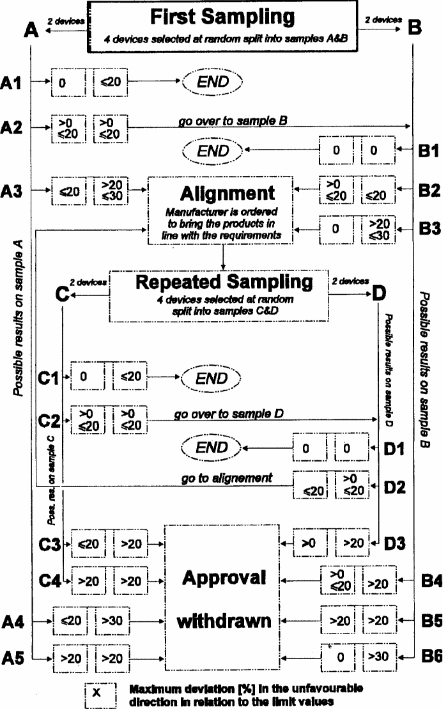
Vehicle Standard (Australian Design Rule 76/0076/00 – Daytime Running LampsDaytime Running Lamps) 20062006
I, JAMES ERIC LLOYD, Minister for Local Government, Territories and Roads, determine this vehicle standard under subsection 7 (1) of the Motor Vehicle Standards Act 1989.
Dated 5 July 2022
[Signed]
James Eric Lloyd
Minister for Local Government, Territories and Roads
CONTENTS
0. legislative provisions..............................................
1. SCOPE.........................................................
2. APPLICABILITY AND IMPLEMENTATION.........................
3. DEFINITIONS...................................................
4. REQUIREMENTS................................................
5. EXEMPTIONS AND ALTERNATIVE PROCEDURES..................
6. SUPPLEMENTARY GENERAL REQUIREMENTS....................
7. ALTERNATIVE STANDARDS.....................................
8. NOTES.........................................................
APPENDIX A..........................................................
0. legislative provisions
0.1. NAME OF STANDARD
0.1.1. This Standard is the Vehicle Standard (Australian Design Rule 76/00 – Daytime Running Lamps) 2006.
0.1.2. This Standard may also be cited as Australian Design Rule 76/00 — Daytime Running Lamps.
0.2. COMMENCEMENT
0.2.1. This Standard commences on the day after it is registered.
0.3. REPEAL
0.3.1. This Standard repeals each vehicle standard with the name Australian Design Rule 76/00 — Daytime Running Lamps that is:
(a) made under section 7 of the Motor Vehicle Standards Act 1989; and
(b) in force at the commencement of this Standard.
0.3.2. This Standard also repeals each instrument made under section 7 of the Motor Vehicle Standards Act 1989 that creates a vehicle standard with the name Australian Design Rule 76/00 — Daytime Running Lamps, if there are no other vehicle standards created by that instrument, or amendments to vehicle standards made by that instrument, that are still in force at the commencement of this Standard.
- SCOPE
This Australian Design Rule (ADR) prescribes the photometric requirements for daytime running lamps which when provided is intended to increase the conspicuity of a vehicle in daylight.
2. APPLICABILITY AND IMPLEMENTATION
2.1. The circumstances under which daytime running lamps are mandatory, optional, or prohibited are set out in either ADRs 13/…, 19/… or 67/….
3. DEFINITIONS
3.1. Refer to paragraph 2 of Appendix A.
4. REQUIREMENTS
4.1. Devices complying with the technical requirements of Appendix A as varied by part 5 Exemptions and Alternative Procedures and part 6 Supplementary General Requirements shall be accepted as complying with this rule.
5. EXEMPTIONS AND ALTERNATIVE PROCEDURES
5.1. The following provisions of appendix A do not apply.
5.1.1. Section 3 Application for approval
Section 4 Markings
Section 5 Approval
Section 12 Modification of a type of daytime running lamp and extension of approval
Section 15 Production definitely discontinued
Section 16 Names and addresses of technical services responsible for conducting approval tests, and of administrative departments
Section 14 Transitional provisions
Annexes
Annex 1 Communication concerning the approval (or refusal or withdrawal of approval or production definitely discontinued) of a type of reflex reflecting device pursuant to Regulation No. 87
Annex 2 Examples of arrangements of approval marks
5.1.2. Paragraphs 2.3 and 3.3 in Annex 6.
6. SUPPLEMENTARY GENERAL REQUIREMENTS
The following general requirements are supplementary to the requirements of appendix A.
6.1. The requirements and procedures set out in Annexes 5 and 6 of Appendix A are acceptable for the purposes of demonstrating compliance with the technical requirements of this rule.
7. ALTERNATIVE STANDARDS
7.1. The technical requirements of any of the editions of the United Nations – Economic Commission for Europe (UN ECE) Regulation No. 87 - UNIFORM PROVISIONS CONCERNING THE APPROVAL OF DAYTIME RUNNING LAMPS FOR POWER DRIVEN VEHICLES incorporating the 01 series of amendments are deemed to be equivalent to the technical requirements of this rule.
8. NOTES
8.1. In place of Regulation No 48 where referenced in Appendix A, read ADR 13/00.
8.2. In place of Regulation No 37 where referenced in Appendix A, read ADR 51/00.
APPENDIX A
UN-ECE REGULATION NO. 87/01
UNIFORM PROVISIONS CONCERNING THE APPROVAL OF DAYTIME RUNNING LAMPS FOR POWER DRIVEN VEHICLES
Regulation No. 87
UNIFORM PROVISION CONCERNING THE APPROVAL OF DAYTIME RUNNING LAMPS FOR POWER DRIVEN VEHICLES
CONTENTS
REGULATION
1. SCOPE
2. DEFINITIONS
3. APPLICATIONS FOR APPROVAL
4. MARKINGS
5. APPROVAL
6. GENERAL SPECIFICATIONS
7. INTENSITY OF LIGHT
8. ILLUMINATING SURFACE
9. COLOUR OF LIGHT
10. TEST PROCEDURE
11. HEAT RESISTANCE TEST
12. MODIFICATIONS OF A TYPE OF DAYTIME RUNNING LAMP AND EXTENSION OF APPROVAL
13. CONFORMITY OF PRODUCTION
14. PENALTIES FOR NON-CONFORMITY OF PRODUCTION
15. PRODUCTION DEFINITELY DISCONTINUED
16. NAMES AND ADDRESSES OF TECHNICAL SERVICES RESPONSIBLE FOR CONDUCTING APPROVAL TESTS, AND OF ADMINISTRATIVE DEPARTMENTS
ANNEXES
Annex 1: Communication concerning the approval or refusal or extension or withdrawal of approval or production definitely discontinued of a type of daytime running lamp, pursuant to Regulation No. 87 Annex 2: Example of arrangement of the approval mark Example of possible markings for grouped lamps situated at the front of the vehicle Lamp reciprocally incorporated with a head lamp
Annex 3: Photometric measurements
Annex 4: Colour of light - Trichromatic coordinates
Annex 5: Minimum requirements for conformity of production control procedures Annex 6: Minimum requirements for sampling by an inspector
Regulation No. 87
UNIFORM PROVISIONS CONCERNING THE APPROVAL OF DAYTIME RUNNING LAMPS FOR POWER-DRIVEN VEHICLES
1. SCOPE
This Regulation applies to the approval of lamps intended to increase conspicuity of a vehicle in daylight.
2. DEFINITIONS
For the purpose of this regulation:
2.1. "Daytime running lamp" means a lamp facing in a forward direction used to make the vehicle more easily visible when driving during daytime;
2.2. The definitions given in Regulation No. 48 and its series of amendments in force at the time of application for type approval shall apply to this Regulation.
2.3. Daytime running lamps of different "types" are daytime running lamps which differ in such essential respects as:
2.3.1. the trade name or mark,
2.3.2. the characteristics of the optical system,
2.3.3. the category of filament lamp.
3. APPLICATION FOR APPROVAL
3.1. The application for approval shall be submitted by the holder of the trade name or mark or by his duly accredited representative.
3.2. For each type of daytime running lamp, the application shall be accompanied by:
3.2.1. drawings (three copies in sufficient detail to permit identification of the type of the daytime running lamp and showing geometrically the position in which the daytime running lamp is to be fitted to the vehicles, the axis of observation to be taken as the axis of reference in the tests (horizontal angle H = 0 degrees , vertical angle V = 0 degrees ): and the point to be taken as the centre of reference in the said tests: and the illuminating surface,
3.2.2. a brief technical description stating, in particular, with the exception of lamps with non- replaceable light sources, the category(ies) of filament lamp(s) which is to be used; this filament lamp category shall be one of those contained in Regulation No. 37,
3.2.3. two lamps.
4. MARKINGS
Daytime running lamps submitted for approval shall,
4.1. bear on the lens the trade name or mark of the applicant, this marking must be clearly legible and be indelible,
4.2. bear a clearly legible and indelible marking showing the category(ies) of the filament lamp(s) which is (are) to be used; this is not valid for lamps with non-replaceable light sources,
4.3. in the case of a daytime running lamp with non-replaceable light sources bear the marking of rated voltage and rated wattage,
4.4. provide adequate space for the approval mark and for the additional symbols prescribed in paragraph 5.2 below, the said space shall be shown in the drawings referred to in paragraph 3.2.1 above.
5. APPROVAL
5.1. General
5.1.1. If the two lamps which are submitted in pursuance of paragraph 3.2.3 above satisfy the requirements of this Regulation, approval shall be granted.
5.1.2. Where grouped, combined or reciprocally incorporated lamps have been found to comply with the requirements of several Regulations annexed to the 1958 Agreement, a single international approval mark may be applied provided that such lamps are not grouped, combined or reciprocally incorporated with a lamp or lamps not satisfying any one of these Regulations.
5.1.3. An approval number shall be assigned to each type approved. Its first two digits (at present 00 for the Regulation in its original form) shall indicate the series of amendments incorporating the most recent major technical amendments made to the Regulation at the time of issue of the approval. The same Contracting Party shall not assign this number to another type of lamp covered by this Regulation.
5.1.4. Notice of approval or of extension of refusal or withdrawal of approval or production definitely discontinued of a type of lamp pursuant to this Regulation shall be communicated to the Parties to the Agreement which apply this Regulation, by means of a form conforming to the model in annex 1 to this Regulation.
5.1.5. Every lamp conforming to a type approved under this Regulation shall bear, in the space referred to in paragraph 4.4 above, an approval mark as described in paragraphs 5.2 and 5.3 below.
5.1.6. The mark and symbols mentioned in paragraph 5.2 shall be indelible and clearly legible even when the lamp is mounted on the vehicle.
5.2. Composition of the approval mark
The approval mark shall consist of:
5.2.1. an international approval marking, comprising:
5.2.1.1. a circle surrounding the letter "E" followed by the distinguishing number of the country which has granted the approval,
5.2.1.2. an approval number,
5.2.2. the additional symbol "RL".
5.2.3. The two digits of the approval number which indicate the series of amendments in force at the time of issue of the approval, may be marked close to the above additional symbols.
5.3. Arrangement of the approval mark
5.3.1. Independent lamps
Annex 2, figure 1, to this Regulation gives an example of arrangement of the approval mark with the above-mentioned additional symbols.
5.3.2. Grouped, combined or reciprocally incorporated lamps
5.3.2.1. Where grouped, combined or reciprocally incorporated lamps have been found to comply with the requirements of several Regulations, a single international approval mark may be affixed, consisting of a circle surrounding the letter "E" followed by the distinguishing number of the country which has granted the approval, and an approval number. This approval mark may be located anywhere on the grouped, combined or reciprocally incorporated lamps, provided that:
5.3.2.1.1. it is visible after their installation.
5.3.2.1.2. no part of the grouped, combined or reciprocally incorporated lamps that transmits light can be removed without at the same time removing the approval mark.
5.3.2.2. The identification symbol for each lamp appropriate to each Regulation under which approval has been granted, together with the corresponding series of amendments incorporating the most recent major technical amendments to the Regulation at the time of issue of the approval and, if necessary, the required arrow shall be marked:
5.3.2.2.1. either on the appropriate illuminating surface,
5.3.2.2.2. or in a group, in such a way that each of the grouped, combined or reciprocally incorporated lamps may be clearly identified.
5.3.2.3. The size of the components of a single approval mark shall not be less than the minimum size required for the smallest of the individual marks by the Regulation under which approval has been granted.
5.3.2.4. An approval number shall be assigned to each type approved. The same Contracting Party may not assign the same number to another type of grouped, combined or reciprocally incorporated lamps covered by this Regulation.
5.3.2.5. Annex 2, figure 2, to this Regulation gives examples of arrangements of approval marks for grouped, combined or reciprocally incorporated lamps with all the above-mentioned additional symbols.
5.3.3. Lamps reciprocally incorporated with other lamps, of which the lens may also be used for other types of devices
The provisions laid down in paragraph 5.3.2 above are applicable.
5.3.3.1. In addition, where the same lens is used, the latter may bear the different approval marks relating to the different types of headlamps or units of lamps, provided that the main body of the device, even if it cannot be separated from the lens, also comprises the space described in paragraph 4.4 above and bears the approval marks of the actual functions. If different types of devices comprise the same main body, the latter may bear the different approval marks.
5.3.3.2. Annex 2, figure 3, to this Regulation gives examples of arrangements of approval marks relating to the above case.
6. GENERAL SPECIFICATIONS
6.1. Each lamp shall conform to the specifications set forth in the paragraphs below.
6.2. Daytime running lamps shall be so designed and constructed that in normal use, despite the vibration to which they may then be subjected, they continue to function satisfactorily and retain the characteristics prescribed by this Regulation.
7. INTENSITY OF LIGHT
7.1. The intensity of the light emitted by each lamp shall be not less than 400 cd in the axis of reference.
7.2. Outside the reference axis, in each direction corresponding to the points in the light distribution table reproduced in annex 3 to this Regulation, the intensity of the light emitted by each lamp shall be not less than the product of the minimum specified in paragraph 7.1 above by the percentage specified in the said table for the direction in question.
7.3. The intensity of the light emitted shall not be more than 800 cd in any direction.
7.4. In the case of a lamp containing more than one light source the lamp shall comply with the minimum intensity required when any one light source has failed and when all light sources are illuminated the maximum intensity shall not be exceeded.
8. ILLUMINATING SURFACE
The area of the illuminating surface shall be not less than 40 cm2.
9. COLOUR OF LIGHT
The colour of the light shall be white. It shall be measured by using a source of light at a colour temperature of 2856 degrees K (corresponding to illuminant A of the International Commission on Illumination (CIE). However, for lamps equipped with non-replaceable light sources (filament lamps and other), the colorimetric characteristics should be verified with the light sources present in the lamp, in accordance with paragraph 10.2 of this Regulation. The colour must be within the limits of the trichromatic co-ordinates prescribed in annex 4 to this Regulation.
10. TEST PROCEDURE
10.1. All measurements shall be carried out with a colourless standard filament lamp of the category indicated for the daytime running lamp adjusted to produce the reference luminous flux specified for this category of filament lamp.
10.2. All measurements on lamps equipped with non-replaceable light sources (filament lamps and other) shall be made at 6.75 V, 13.5 V or 28.0 V respectively.
In the case of light sources supplied by a special power supply, the above test voltages shall be applied to the input terminals of that power supply. The test laboratory may require from the manufacturer the special power supply needed to supply the light sources.
11. HEAT RESISTANCE TEST
11.1. The lamp must be subjected to a one-hour test of continuous operation following a warm-up period of 20 minutes. The ambient temperature shall be 23 degrees C +/- 5 degrees . The filament lamp used shall be a filament lamp of the category specified for the lamp, and shall be supplied with a current at a voltage such that it gives the specified average power at the corresponding test voltage.
However, for lamps equipped with non-replaceable light sources (filament lamps and other), the test shall be made with the light sources present in the lamps, in accordance with paragraph 10.2 of this Regulation.
11.2. Where only the maximum power is specified, the test shall be carried out by regulating the voltage to obtain a power equal to 90% of the specified power. The specified average or maximum power referred to above shall in all cases be chosen from the voltage range of 6, 12 or 24 V at which it reaches the highest value; for lamps equipped with non-replaceable light sources (filament lamps and other) the test conditions set in paragraph 10.2. of this Regulation shall be applied.
11.3. After the lamp has been stabilized at the ambient temperature, no distortion, deformation, cracking or colour modification shall be perceptible. In case of doubt the intensity of light according to paragraph 7 above shall be measured. At that measurement the values shall reach at least 90% of the values obtained before the heat resistance test on the same device.
12. MODIFICATIONS OF A TYPE OF DAYTIME RUNNING LAMP AND EXTENSION OF APPROVAL
12.1. Every modification of the type of lamp shall be notified to the administrative department which approved the type of lamp.
The department may then either:
12.1.1. Consider that the modifications made are unlikely to have an appreciable adverse effect and that in any case the lamp still complies with the requirements; or
12.1.2. Require a further test report from the technical service responsible for conducting the tests.
12.2. Confirmation or refusal of approval, specifying the alterations shall be communicated by the procedure specified in paragraph 5.1.4 above to the Parties to the Agreement applying this Regulation.
12.3. The competent authority issuing the extension of approval shall assign a series number for such an extension and inform thereof the other Parties to the Agreement applying this Regulation by means of a communication form conforming to the model in annex 1 to this Regulation.
13. CONFORMITY OF PRODUCTION
The conformity of production procedures shall comply with those set out in the Agreement, Appendix 2 (E/ECE/324-E/ECE/TRANS/505/Rev.2), with the following requirements:
13.1. Lamps approved under this Regulation shall be so manufactured as to conform to the type approved by meeting the requirements set forth in paragraphs 6, 7, 8 and 9 above.
13.2. The minimum requirements for conformity of production control procedures set forth in annex 5 to this Regulation shall be complied with.
13.3. The minimum requirements for sampling by an inspector set forth in annex 8 to this Regulation shall be complied with.
13.4. The authority which has granted type approval may at any time verify the conformity control methods applied in each production facility. The normal frequency of these verifications shall be once every two years.
14. PENALTIES FOR NON-CONFORMITY OF PRODUCTION
14.1. The approval granted in respect of a type of daytime running lamp pursuant to this Regulation may be withdrawn if the requirements are not complied with or if a daytime running lamp bearing the approval mark does not conform to the type approved.
14.2. If a Party to the Agreement applying this Regulation withdraws an approval it has previously granted, it shall forthwith so notify the other Contracting Parties applying this Regulation by means of a communication form conforming to the model in annex 1 to this Regulation.
15. PRODUCTION DEFINITELY DISCONTINUED
If the holder of the approval completely ceases to manufacture a type of daytime running lamp approved in accordance with this Regulation, he shall so inform the authority which granted the approval. Upon receiving the relevant communication, that authority shall inform thereof the other Parties to the Agreement applying this Regulation by means of a communication form conforming to the model in annex 1 to this Regulation.
16. NAMES AND ADDRESSES OF TECHNICAL SERVICES RESPONSIBLE FOR CONDUCTING APPROVAL TESTS AND OF ADMINISTRATIVE DEPARTMENTS
The Parties to the Agreement applying this Regulation shall communicate to the United Nations Secretariat the names and addresses of the technical services responsible for conducting approval tests and of the administrative departments which grant approval and to which forms certifying approval or extension or refusal or withdrawal of approval, or production definitely discontinued, issued in other countries, are to be sent.
Annex 1
COMMUNICATION
(maximum format: A4 (210 x 297 mm))
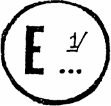 issued by: Name of administration:
issued by: Name of administration:
......................................
......................................
......................................
concerning: APPROVAL GRANTED
APPROVAL EXTENDED
APPROVAL REFUSED
APPROVAL WITHDRAWN
PRODUCTION DEFINITELY DISCONTINUED
of a type of daytime running lamp pursuant to Regulation No. 87
Approval No. .......... Extension No. ..........
1. Trade name or mark of the device:............................................................................
2. Manufacturer's name for the type of device:...........................................................
3. Manufacturer's name and address:
4. If applicable, name and address of the manufacturer's representative:
5. Submitted for approval on:......................................................................................
6. Technical service responsible for conducting approval tests:..................................
7. Date of test report issued by that service:.................................................................
8. Number of test report issue by that service:.............................................................
9. Concise description:.................................................................................................
Number and category of filament lamps: ………………….................................
10. Position of the approval mark:..................................................................................
11. Reason(s) for extension (if applicable):....................................................................
12. Approval granted/refused, extended/withdrawn: 2/
13. Place:.......................................................................................................................
14. Date:.........................................................................................................................
15. Signature:..................................................................................................................
16. The following documents, bearing the approval number shown above, are available on request: ..............................................................................................
Annex 2
EXAMPLE OF ARRANGEMENT OF THE APPROVAL MARK
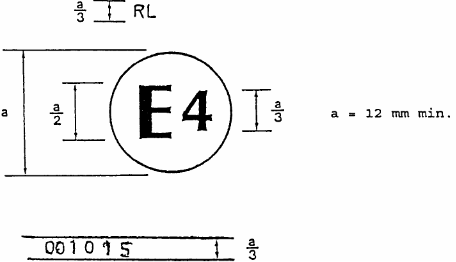
Figure 1
The daytime running lamp bearing the approval mark shown above has been approved in the Netherlands (E4) under number 001015. The approval number indicates that the approval was granted according to the requirements of this Regulation in its original (unamended) form.
Note: The approval number and the additional symbol must be placed close to the circle and either above or below the "E" or to the left or right of that letter. The digits of the approval number must be on the same side of the "E" and face the same direction. The use of roman numerals as approval numbers should be avoided so as to prevent any confusion with other symbols.
Examples of possible markings for grouped lamps situated at the front of the vehicle
Figure 2
The vertical and horizontal lines schematize the shape of the lighting device. These are not part of the approval mark.
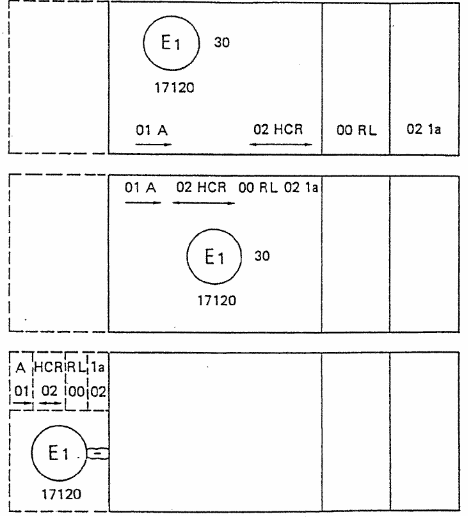
Note: The three examples shown above correspond to a lighting device bearing an approval mark relating to:
A front position lamp approved in accordance with the 01 series of amendments to Regulation No. 7;
A headlamp with a passing beam designed for right-hand and left-hand traffic and a driving beam with a maximum intensity comprised between 86,250 and 101,250 candelas, approved in accordance with the 02 series of amendments to Regulation No. 8;
A daytime running lamp approved in accordance with Regulation No. ...in its original form;
A front direction indicator lamp of category 1a approved in accordance with the 02 series of amendments to Regulation No. 6.
Lamp reciprocally incorporated with a headlamp
Figure 3
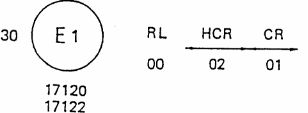
The above example corresponds to the marking of a lens intended to be used in different types of headlamps, namely:
either: a headlamp with a passing beam designed for right-hand and left-hand traffic and a driving beam with a maximum intensity comprised between 86,250 and 101,250 candelas, approved in Germany (E1) in accordance with the requirements of Regulation No. 8 as amended by the 02 series of amendments,
which is reciprocally incorporated with
a daytime running lamp approved in accordance with Regulation No. ... in its original form;
or: a headlamp with a passing beam designed for right-hand and left-hand traffic and a driving beam, approved in Germany (E1) in accordance with the requirements of Regulation No. 1 as amended by the 01 series of amendments,
which is reciprocally incorporated with
the same daytime running lamp as above;
or even: either of the above-mentioned headlamps approved as a single lamp.
The main body of the headlamp shall bear the only valid approval number, for instance:

Annex 3
PHOTOMETRIC MEASUREMENTS
1. When photometric measurements are taken, stray reflections shall be avoided by appropriate masking.
2. In the event that the results of measurements are challenged, measurements shall be taken in such a way as to meet the following requirements:
2.1. the distance of measurement shall be such that the law of the inverse of the square of the distance is applicable:
2.2. the measuring equipment shall be such that the angle subtended by the receiver from the reference centre of the light is between 10' and 1 degrees :
2.3. the intensity requirement for a particular direction of observation shall be satisfied if the required intensity is obtained in a direction deviating by not more than one-quarter of a degree from the direction of observation.
3. Table of standard light distribution
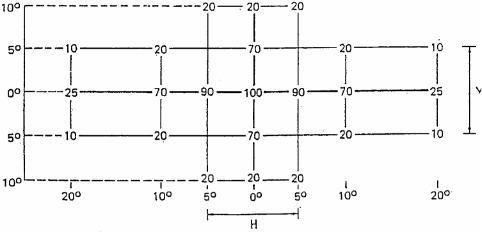
3.1. The direction H = 0 degrees and V = 0 degrees corresponds to the reference axis. (On the vehicle, it is horizontal, parallel to the median longitudinal plane of the vehicle and oriented in the required direction of visibility). It passes through the centre of reference. The values shown in the table give, for the various directions of measurement, the minimum intensities as a percentage of the minimum required in the axis for each lamp (in the direction H = 0 degrees and V = 0 degrees ).
3.2. Within the field of light distribution of paragraph 3 above schematically shown as a grid, the light pattern should be substantially uniform, i.e. in so far as the light intensity in each direction of a part of the field formed by the grid lines shall meet at least the lowest minimum value being shown on the grid lines surrounding the questioned direction as a percentage.
Annex 4
COLOUR OF LIGHT TRICHROMATIC COORDINATES
WHITE
Limit towards blue | X> 0.310 |
Limit towards yellow | X< 0.500 |
Limit towards green | Y< 0.150 + 0.640 X Y< 0.440 |
Limit towards purple | Y> 0.050 + 0.750 X |
Limit towards red | Y> 0.382 |
CORNER POINTS
X | Y |
0.310 | 0.348 |
0.310 | 0.283 |
0.443 | 0.382 |
0.500 | 0.382 |
0.500 | 0.440 |
0.453 | 0.440 |
Annex 5
MINIMUM REQUIREMENTS FOR CONFORMITY OF PRODUCTION CONTROL PROCEDURES
1. GENERAL
1.1. The conformity requirements shall be considered satisfied from a mechanical and geometric standpoint, if the differences do not exceed inevitable manufacturing deviations within the requirements of this Regulation.
1.2. With respect to photometric performances, the conformity of mass-produced lamps shall not be contested if, when testing photometric performances of any lamp chosen at random and equipped with a standard filament lamp, or when the lamps are equipped with non-replaceable light sources (filament lamps or other), and when all measurements are made at 6.75 V, 13.5 V or 28.0 V respectively:
1.2.1. no measured value deviates unfavourably by more than 20% from the values prescribed in this Regulation.
1.2.2. If, in the case of a lamp equipped with a replaceable light source and if results of the test described above do not meet the requirements, tests on lamps shall be repeated using another standard filament lamp.
1.3. The chromaticity coordinates shall be complied with when the lamp is equipped with a standard filament lamp, or for lamps equipped with non-replaceable light sources (filament lamps or other), when the colorimetric characteristics are verified with the light source present in the lamp.
2. MINIMUM REQUIREMENTS FOR VERIFICATION OF CONFORMITY BY THE MANUFACTURER
For each type of lamp the holder of the approval mark shall carry out at least the following tests, at appropriate intervals. The tests shall be carried out in accordance with the provisions of this Regulation.
If any sampling shows non-conformity with regard to the type of test concerned, further samples shall be taken and tested. The manufacturer shall take steps to ensure the conformity of the production concerned.
2.1. Nature of tests
Tests of conformity in this Regulation shall cover the photometric and colorimetric characteristics.
2.2. Methods used in tests
2.2.1. Tests shall generally be carried out in accordance with the methods set out in this Regulation.
2.2.2. In any test of conformity carried out by the manufacturer, equivalent methods may be used with the consent of the competent authority responsible for approval tests. The manufacturer is responsible for proving that the applied methods are equivalent to those laid down in this Regulation.
2.2.3. The application of paragraphs 2.2.1. and 2.2.2. requires regular calibration of test apparatus and its correlation with measurements made by a competent authority.
2.2.4. In all cases the reference methods shall be those of this Regulation, particularly for the purpose of administrative verification and sampling.
2.3. Nature of sampling
Samples of lamps shall be selected at random from the production of a uniform batch. A uniform batch means a set of lamps of the same type, defined according to the production methods of the manufacturer.
The assessment shall in general cover series production from individual factories. However, a manufacturer may group together records concerning the same type from several factories, provided these operate under the same quality system and quality management.
2.4. Measured and recorded photometric characteristics
The sampled lamp shall be subjected to photometric measurements for the minimum values at the points listed in annex 3 and the chromaticity coordinates listed in annex 4, provided for in the Regulation.
2.5. Criteria governing acceptability
The manufacturer is responsible for carrying out a statistical study of the test results and for defining, in agreement with the competent authority, criteria governing the acceptability of his products in order to meet the specifications laid down for verification of conformity of products in paragraph 13.1. of this Regulation.
The criteria governing the acceptability shall be such that, with a confidence level of 95%, the minimum probability of passing a spot check in accordance with annex 6 (first sampling) would be 0.95.
Annex 6
MINIMUM REQUIREMENTS FOR SAMPLING BY AN INSPECTOR
1. GENERAL
1.1. The conformity requirements shall be considered satisfied from a mechanical and a geometric standpoint, in accordance with the requirements of this Regulation, if any, if the differences do not exceed inevitable manufacturing deviations.
1.2. With respect to photometric performance, the conformity of mass-produced lamps shall not be contested if, when testing photometric performances of any lamp chosen at random and equipped with a standard filament lamp, or when the lamps are equipped with non-replaceable light sources (filament lamps or other), and when all measurements are made at 6.75 V, 13.5 V or 28.0 V respectively:
1.2.1. no measured value deviates unfavourably by more than 20% from the values prescribed in this Regulation.
1.2.2. If, in the case of a lamp equipped with a replaceable light source and if results of the test described above do not meet the requirements, tests on lamps shall be repeated using another standard filament lamp.
1.2.3. Lamps with apparent defects are disregarded.
1.3. The chromaticity coordinates shall be complied with when the lamp is equipped with a standard filament lamp, or for lamps equipped with non-replaceable light sources (filament lamps or other), when the colorimetric characteristics are verified with the light source present in the lamp.
2. FIRST SAMPLING
In the first sampling four lamps are selected at random. The first sample of two is marked A, the second sample of two is marked B.
2.1. The conformity is not contested
2.1.1. Following the sampling procedure shown in Figure 1 of this annex the conformity of mass-produced lamps shall not be contested if the deviation of the measured values of the lamps in the unfavourable directions are:
2.1.1.1. sample A
A1: one lamp...................................................................................0%
one lamp not more than..........................................................20%
A2: both lamps more than...............................................................0%
but not more than....................................................................20%
go to sample B
2.1.1.2. sample B
B1: both lamps...............................................................................0%
2.1.2. or, if the conditions of paragraph 1.2.2. for sample A are fulfilled.
2.2. The conformity is contested
2.2.1. Following the sampling procedure shown in Figure 1 of this annex the conformity of mass-produced lamps shall be contested and the manufacturer requested to make his production meet the requirements (alignment) if the deviations of the measured values of the lamps are:
2.2.1.1. sample A
A3: one lamp not more than..........................................................20%
one lamp more than................................................................20%
but not more than.....................................................................30%
2.2.1.2. sample B
B2: in the case of A2
one lamp more than..................................................................0%
but not more than.....................................................................20%
one lamp not more than............................................................20%
B3:in the case of A2
one lamp....................................................................................0%
one lamp more than..................................................................20%
but not more than...................................................................30%
2.2.2. or, if the conditions of paragraph 1.2.2. for sample A are not fulfilled.
2.3. Approval withdrawn
Conformity shall be contested and paragraph 14. applied if, following the sampling procedure in Figure 1 of this annex, the deviations of the measured values of the lamps are:
2.3.1. sample A
A4: one lamp not more than...........................................................20%
one lamp more than.................................................................30%
A5: both lamps more than.............................................................20%
2.3.2. sample B
B4: in the case of A2
one lamp more than..................................................................0%
but not more than....................................................................20%
one lamp more than................................................................20%
B5: in the case of A2
both lamps more than............................................................20%
B6: in the case of A2
one lamp....................................................................................0%
one lamp more than.................................................................30%
2.3.3. or, if the conditions of paragraph 1.2.2. for samples A and B are not fulfilled.
3. REPEATED SAMPLING
In the cases of A3, B2, B3 a repeated sampling, third sample C of two lamps and fourth sample D of two lamps, selected from stock manufactured after alignment, is necessary within two months ' time after the notification.
3.1. The conformity is not contested
3.1.1. Following the sampling procedure shown in Figure 1 of this annex the conformity of mass-produced lamps shall not be contested if the deviations of the measured values of the lamps are:
3.1.1.1. sample C
C1: one lamp ..................................................................................0%
one lamp not more than…………..........................................20%
C2: both lamps more than ...............................................................0%
but not more than.....................................................................20%
go to sample D
3.1.1.2. sample D
D1: in the case of C2
both lamps.................................................................................0%
3.1.2. or, if the conditions of paragraph 1.2.2. for sample C are fulfilled.
3.2. The conformity is contested
3.2.1. Following the sampling procedure shown in Figure 1 of this annex the conformity of mass-produced lamps shall be contested and the manufacturer requested to make his production meet the requirements (alignment) if the deviations of the measured values of the lamps are:
3.2.1.1. sample D
D2: in the case of C2
one lamp more than...................................................................0%
but not more than.....................................................................20%
one lamp not more than...........................................................20%
3.2.1.2. or, if the conditions of paragraph 1.2.2. for sample C are not fulfilled.
3.3. Approval withdrawn
Conformity shall be contested and paragraph 14. applied if, following the sampling procedure in Figure 1 of this annex, the deviations of the measured values of the lamps are:
3.3.1. sample C
C3: one lamp not more than..........................................................20%
one lamp more than................................................................20%
C4: both lamps more than .............................................................20%
3.3.2. sample D
D3: in the case of C2
one lamp 0 or more than...........................................................0%
one lamp more than.................................................................20%
3.3.3. or, if the conditions of paragraph 1.2.2. for samples C and D are not fulfilled.
Figure 1
